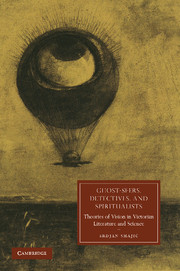Book contents
- Frontmatter
- Contents
- Acknowledgments
- List of abbreviations
- Introduction
- PART I OUTER VISION, INNER VISION: GHOST-SEEING AND GHOST STORIES
- PART II SEEING IS READING: VISION, LANGUAGE, AND DETECTIVE FICTION
- 5 Visual learning: sight and Victorian epistemology
- 6 Scopophilia and scopophobia: Poe's readerly flâneur
- 7 Stains, smears, and visual language in The Moonstone
- 8 Semiotics v. encyclopedism: the case of Sherlock Holmes
- PART III INTO THE INVISIBLE: SCIENCE, SPIRITUALISM, AND OCCULT DETECTION
- Coda
- Notes
- Bibliography
- Index
- CAMBRIDGE STUDIES IN NINETEENTH-CENTURY LITERATURE AND CULTURE
7 - Stains, smears, and visual language in The Moonstone
Published online by Cambridge University Press: 06 July 2010
- Frontmatter
- Contents
- Acknowledgments
- List of abbreviations
- Introduction
- PART I OUTER VISION, INNER VISION: GHOST-SEEING AND GHOST STORIES
- PART II SEEING IS READING: VISION, LANGUAGE, AND DETECTIVE FICTION
- 5 Visual learning: sight and Victorian epistemology
- 6 Scopophilia and scopophobia: Poe's readerly flâneur
- 7 Stains, smears, and visual language in The Moonstone
- 8 Semiotics v. encyclopedism: the case of Sherlock Holmes
- PART III INTO THE INVISIBLE: SCIENCE, SPIRITUALISM, AND OCCULT DETECTION
- Coda
- Notes
- Bibliography
- Index
- CAMBRIDGE STUDIES IN NINETEENTH-CENTURY LITERATURE AND CULTURE
Summary
In an 1864 article entitled “Detectives in Fiction and in Real Life,” James Fitzjames Stephen, one of the preeminent Victorian authorities on English criminal law, observes that, since the time Poe jump-started the genre in the 1840s, detective fiction had become “a well-tried, serviceable, common form which has sold a considerable number of popular novels, and which, in the natural course of things, may be expected to sell several more.” That quantity, however, is no indicator of quality is clear when it comes to detective fiction's improbable epistemological claims:
All these stories are open to the same criticism. Those that hide can find. The person who invented the riddle and knows the explanation is of course able to pretend to discover it by almost any steps, or by what really amount to no steps at all, and thus he can easily convey the impression of the exercise of any amount of sagacity on the part of the person who is supposed to make the discovery. In real life, and especially in the real life of policemen, such discoveries are hardly ever made; and if any one takes the trouble of comparing the actual experience of courts of law with the fictions of novelists as to the extraordinary genius displayed by the detective police, they will find that hardly anything that can be fairly described as remarkable or even peculiar ability is ever shown by the police in finding out a crime.
If detective stories are “all framed upon the same model,” this is principally because they all “involve the same fallacy,” a disingenuous sleight of hand that condemns them “to the same criticism.”
- Type
- Chapter
- Information
- Ghost-Seers, Detectives, and SpiritualistsTheories of Vision in Victorian Literature and Science, pp. 108 - 118Publisher: Cambridge University PressPrint publication year: 2010

